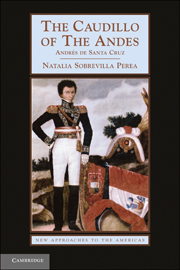Book contents
- Frontmatter
- Contents
- List of Maps and Illustrations
- Timeline for Santa Cruz
- Acknowledgments
- Introduction
- 1 Early Years at the Twilight of the Colonial Period
- 2 Great Marshall of Zepita
- 3 The Creation of Bolivia
- 4 The Genesis of the Peru-Bolivia Confederation
- 5 The Rise and Fall of the Peru-Bolivia Confederation
- 6 Defeat and Exile
- Epilogue: The Long-Term Consequences of the Fall of the Confederation
- Bibliography
- Index
1 - Early Years at the Twilight of the Colonial Period
Published online by Cambridge University Press: 05 June 2012
- Frontmatter
- Contents
- List of Maps and Illustrations
- Timeline for Santa Cruz
- Acknowledgments
- Introduction
- 1 Early Years at the Twilight of the Colonial Period
- 2 Great Marshall of Zepita
- 3 The Creation of Bolivia
- 4 The Genesis of the Peru-Bolivia Confederation
- 5 The Rise and Fall of the Peru-Bolivia Confederation
- 6 Defeat and Exile
- Epilogue: The Long-Term Consequences of the Fall of the Confederation
- Bibliography
- Index
Summary
Andrés de Santa Cruz was born at the end of the colonial period and was part of the generation that lived the transition from being subjects of the Spanish monarchy to becoming citizens in the republican era. To understand the process by which these new countries were created, it is necessary to be aware of the realities that shaped the worldview of men such as Santa Cruz. His childhood was spent in the high Andean region of La Paz and Cuzco and was deeply affected by the Indian rebellions that took place just ten years before his birth. Both his father and grandfather had been involved directly in the fight against the rebels and had suffered from their involvement in the conflict. The world he grew up in was still coming to terms with this legacy of insurrection when another external shock, the taking of the Spanish Peninsula by Napoleon, threw the region once again into disarray. It was in this context that Santa Cruz joined the army at seventeen and fought for a decade to defend the rights of the king in La Paz and later against the troops sent in from Buenos Aires. In 1809, he had his first experience of war, and he was exposed to the realities of fighting in the Andean region. It was also in this context that he grew familiar with the regional sentiment that made people from Arequipa, Cuzco, Puno, Arica, and Tacna fight so decisively to maintain their links to the Altiplano, La Paz, and Potosí.
- Type
- Chapter
- Information
- The Caudillo of the AndesAndrés de Santa Cruz, pp. 22 - 52Publisher: Cambridge University PressPrint publication year: 2011



